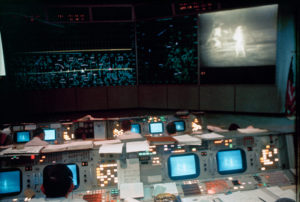
By Calvin D. Blair
About the size of a beach ball, Sputnik I, the world’s first artificial satellite, orbited the Earth in a mere ninety-eight minutes. Even as many Americans rushed outside to watch the first space explorer streak across the sky, the emergence of the Soviet satellite in 1957 wounded their perception of U.S. ideological and technological superiority. In response, the military scrambled to design missiles, politicians deepened their rhetoric, pundits struggled to come to grips with the new world order, and, at President Dwight Eisenhower’s request, the U.S. Congress created the National Aeronautics and Space Administration. Elected in 1960, President John F. Kennedy announced to a joint session of Congress on May 25, 1961, that the United States would place a man on the moon by the end of the decade. Many believed that was an impossible goal, considering the Wright brothers’ first flight had taken place less than sixty years earlier. Nevertheless, Houston rose to the occasion to help fulfill President Kennedy’s vision and, in doing so, became immortalized in one of mankind’s greatest feats: landing on the moon.
To read the full article, click here. “

To visit NASA’s official website click here.
Interested in the space shuttle itself? Click here to read our article “Houston Brings Home a Shuttle For Everyone to Share” By Alicia M. Nichols, or find out more with a visit to the Johnson Space Center.
Want to hear more interviews and oral histories about the iconic mission? Click here.


 Follow
Follow